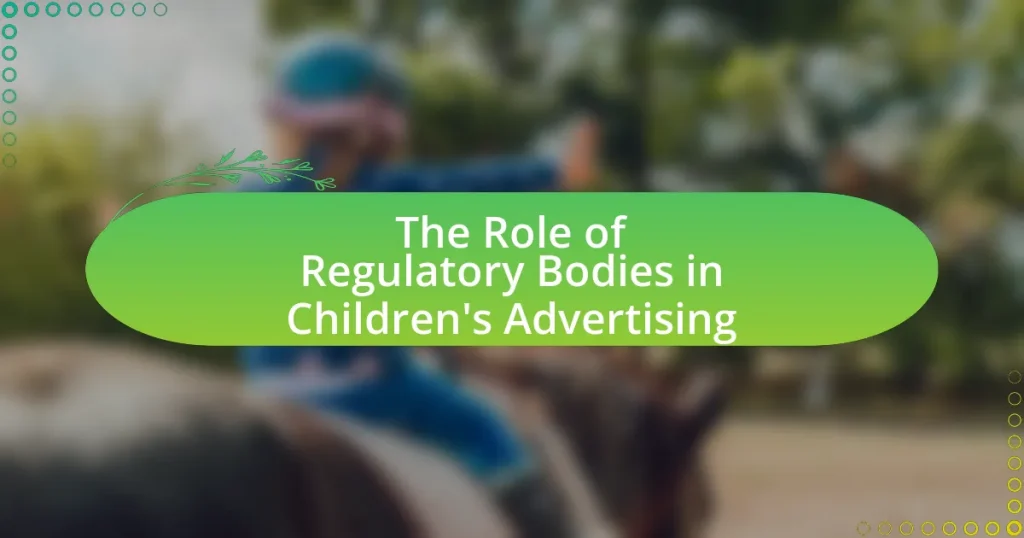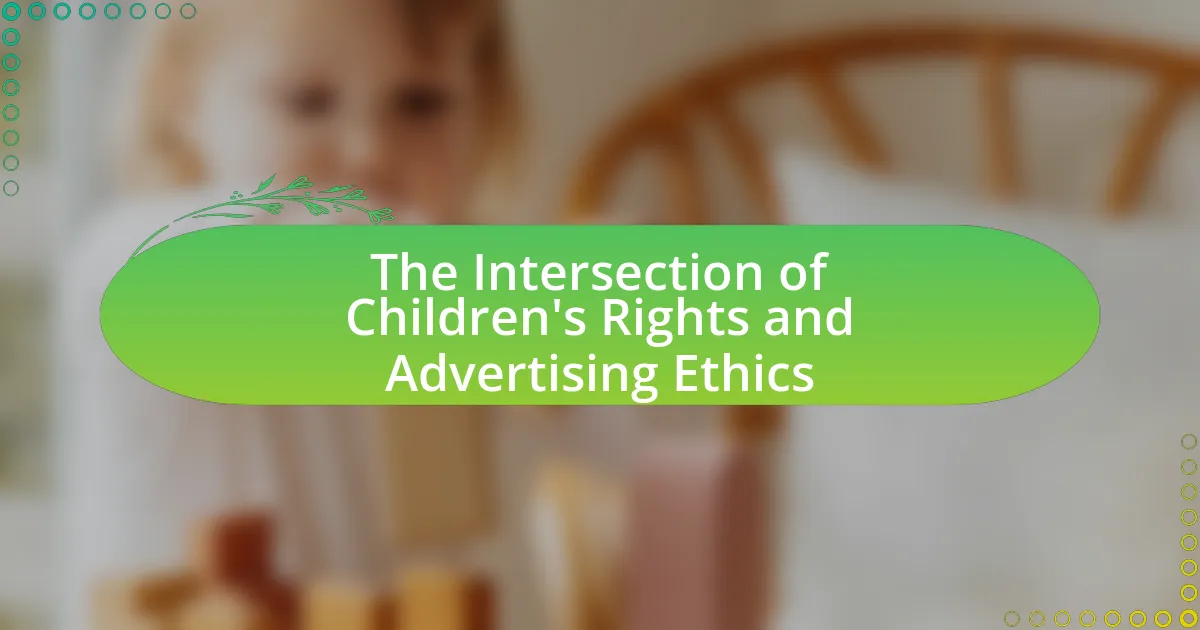Regulatory bodies play a crucial role in children’s advertising by establishing and enforcing guidelines that protect young audiences from misleading and harmful marketing practices. Key organizations such as the Federal Trade Commission (FTC) in the United States and the Advertising Standards Authority (ASA) in the UK ensure that advertisements directed at children are truthful, appropriate, and not exploitative. These bodies monitor compliance, impose penalties for violations, and provide clear guidelines to promote ethical advertising practices. The article explores the specific functions of these regulatory bodies, the challenges they face in the evolving digital landscape, and best practices for advertisers to comply with regulations aimed at safeguarding children’s interests.
What is the Role of Regulatory Bodies in Children’s Advertising?
Regulatory bodies in children’s advertising are responsible for establishing and enforcing guidelines that protect young audiences from misleading or harmful marketing practices. These organizations, such as the Federal Trade Commission (FTC) in the United States and the Advertising Standards Authority (ASA) in the UK, ensure that advertisements directed at children are truthful, not exploitative, and appropriate for their developmental stage. For instance, the Children’s Online Privacy Protection Act (COPPA) mandates that companies obtain parental consent before collecting personal information from children under 13, thereby safeguarding their privacy. Additionally, these regulatory bodies often conduct reviews and impose penalties on advertisers who violate established standards, thereby maintaining ethical advertising practices aimed at children.
Why are regulatory bodies important in children’s advertising?
Regulatory bodies are important in children’s advertising because they establish guidelines that protect young audiences from misleading or harmful content. These organizations, such as the Federal Trade Commission in the United States, enforce rules that ensure advertisements are truthful and appropriate for children, who may not have the ability to critically evaluate marketing messages. For instance, studies have shown that children are particularly susceptible to persuasive techniques used in advertising, making oversight essential to prevent exploitation. By regulating the content and methods used in children’s advertising, these bodies help promote ethical standards and safeguard children’s well-being.
What specific functions do regulatory bodies serve in this context?
Regulatory bodies in the context of children’s advertising serve to protect young audiences from misleading or harmful content. They establish guidelines that restrict the types of advertisements directed at children, ensuring that marketing practices are ethical and do not exploit their vulnerability. For instance, the Children’s Advertising Review Unit (CARU) enforces standards that require advertisements to be truthful and not deceptive, thereby safeguarding children’s interests. Additionally, these bodies monitor compliance with regulations and can impose penalties for violations, reinforcing accountability in advertising practices aimed at children.
How do regulatory bodies ensure compliance with advertising standards?
Regulatory bodies ensure compliance with advertising standards through a combination of monitoring, enforcement, and guidance. They monitor advertisements across various media to identify violations of established standards, such as misleading claims or inappropriate content. For instance, the Federal Trade Commission (FTC) in the United States actively reviews advertisements and can impose penalties for non-compliance. Additionally, these bodies provide clear guidelines and best practices for advertisers, helping them understand the legal requirements and ethical considerations involved in advertising, particularly in sensitive areas like children’s advertising. This proactive approach not only deters non-compliance but also promotes responsible advertising practices.
What are the key regulatory bodies involved in children’s advertising?
The key regulatory bodies involved in children’s advertising include the Federal Trade Commission (FTC) in the United States, the Advertising Standards Authority (ASA) in the United Kingdom, and the Canadian Radio-television and Telecommunications Commission (CRTC) in Canada. The FTC enforces laws against deceptive advertising practices and has specific guidelines for marketing to children, emphasizing the protection of minors from misleading content. The ASA regulates advertising standards in the UK, ensuring that advertisements aimed at children are not misleading or harmful. The CRTC oversees broadcasting regulations in Canada, including advertising content directed at children, to ensure compliance with established standards. These organizations collectively aim to safeguard children’s interests in advertising across different jurisdictions.
What are the roles of the Federal Trade Commission (FTC) in the U.S.?
The Federal Trade Commission (FTC) in the U.S. is responsible for protecting consumers and ensuring a competitive marketplace. Its roles include enforcing laws against deceptive advertising, including those targeted at children, and promoting fair competition among businesses. The FTC monitors advertising practices to prevent misleading claims and has the authority to take action against companies that violate consumer protection laws. For instance, the Children’s Online Privacy Protection Act (COPPA) is enforced by the FTC to safeguard children’s personal information online, demonstrating its commitment to protecting young consumers.
How does the Advertising Standards Authority (ASA) operate in the UK?
The Advertising Standards Authority (ASA) operates in the UK by regulating advertising to ensure it is legal, decent, honest, and truthful. The ASA enforces the UK Code of Non-broadcast Advertising and Direct & Promotional Marketing, which sets standards for advertising content. It investigates complaints from the public and businesses about misleading or harmful advertisements, taking action to remove or amend ads that do not comply with the code. In 2022, the ASA resolved over 30,000 complaints, demonstrating its active role in maintaining advertising standards. The ASA also provides guidance to advertisers to help them understand and comply with the regulations, thereby promoting responsible advertising practices.

How do regulatory bodies influence advertising practices for children?
Regulatory bodies influence advertising practices for children by establishing guidelines and restrictions that limit the types of content and methods used in marketing directed at young audiences. For instance, the Federal Trade Commission (FTC) in the United States enforces regulations that prohibit deceptive advertising practices and require that advertisements aimed at children be clearly distinguishable from programming. Additionally, the Children’s Advertising Review Unit (CARU) sets standards for responsible advertising to children, focusing on issues such as the appropriateness of content and the need for truthfulness. These regulatory frameworks are designed to protect children from exploitation and ensure that advertising does not mislead or harm them, reflecting a commitment to child welfare in marketing practices.
What guidelines do regulatory bodies establish for children’s advertising?
Regulatory bodies establish guidelines for children’s advertising to protect young audiences from misleading or harmful content. These guidelines typically include restrictions on the use of deceptive practices, such as exaggerating product benefits or using fear tactics. For example, the Federal Trade Commission (FTC) in the United States emphasizes that advertisements must be truthful and not misleading, particularly when targeting children, who may not fully understand the persuasive intent of advertising. Additionally, many regulatory frameworks require that advertisements for food products aimed at children adhere to nutritional standards to combat childhood obesity. These measures are supported by research indicating that children are particularly vulnerable to advertising influences, necessitating stricter regulations to ensure their well-being.
What are the restrictions on content aimed at children?
Restrictions on content aimed at children include prohibitions against misleading advertising, the promotion of unhealthy food and beverages, and the use of exploitative techniques that could manipulate children’s emotions or inexperience. Regulatory bodies, such as the Federal Trade Commission (FTC) in the United States and the Advertising Standards Authority (ASA) in the UK, enforce these restrictions to protect children from harmful marketing practices. For example, the Children’s Online Privacy Protection Act (COPPA) mandates that websites directed at children under 13 must obtain parental consent before collecting personal information, ensuring that children’s privacy is safeguarded.
How do these guidelines address issues of misleading advertising?
These guidelines address issues of misleading advertising by establishing clear standards that prohibit deceptive practices aimed at children. They require that advertisements be truthful, not misleading, and clearly distinguish between content and advertising, ensuring that children can easily recognize promotional material. For instance, the guidelines mandate that claims made in advertisements must be substantiated, which helps prevent the dissemination of false information that could mislead young audiences. This approach is supported by research indicating that children are particularly vulnerable to misleading advertising due to their cognitive development stages, emphasizing the need for stringent regulations to protect them.
How do regulatory bodies monitor compliance in children’s advertising?
Regulatory bodies monitor compliance in children’s advertising through a combination of guidelines, audits, and enforcement actions. These organizations, such as the Federal Trade Commission (FTC) in the United States and the Advertising Standards Authority (ASA) in the UK, establish specific regulations that dictate how advertisements should be designed and presented to children, ensuring that they are not misleading or harmful. For instance, the Children’s Online Privacy Protection Act (COPPA) mandates that companies obtain parental consent before collecting personal information from children under 13, which regulatory bodies enforce through investigations and penalties for non-compliance. Additionally, these bodies conduct regular reviews of advertising content and may respond to complaints from the public, ensuring that advertisers adhere to established standards that protect children’s interests.
What methods do regulatory bodies use to assess advertising practices?
Regulatory bodies assess advertising practices through a combination of monitoring, compliance checks, and consumer feedback analysis. These methods involve reviewing advertisements for adherence to established guidelines, conducting audits to ensure compliance with legal standards, and analyzing complaints from consumers to identify misleading or harmful content. For instance, the Federal Trade Commission (FTC) in the United States employs these methods to protect consumers, particularly children, from deceptive advertising practices. This approach is supported by data indicating that regulatory oversight can significantly reduce instances of misleading advertisements, thereby promoting ethical advertising standards.
How do they respond to violations of advertising regulations?
Regulatory bodies respond to violations of advertising regulations by investigating complaints, imposing fines, and requiring corrective actions from advertisers. For instance, the Federal Trade Commission (FTC) in the United States actively monitors advertising practices and has the authority to penalize companies that engage in deceptive marketing, particularly in children’s advertising, where stricter guidelines apply. In 2020, the FTC took action against a company for misleading claims in advertisements directed at children, demonstrating their commitment to enforcing compliance and protecting young audiences from harmful advertising practices.
What challenges do regulatory bodies face in children’s advertising?
Regulatory bodies face significant challenges in children’s advertising, primarily due to the evolving digital landscape and the need to protect vulnerable audiences. One major challenge is the rapid growth of online platforms, which complicates the enforcement of existing regulations designed for traditional media. For instance, the rise of social media influencers targeting children often blurs the lines between advertising and organic content, making it difficult for regulators to identify and address misleading practices. Additionally, the diverse cultural and legal standards across different regions create inconsistencies in regulatory approaches, hindering effective enforcement. According to a report by the American Psychological Association, children are particularly susceptible to advertising tactics, which raises ethical concerns about their exposure to potentially harmful content. These factors collectively complicate the regulatory landscape, making it challenging for bodies to ensure that advertising practices are both fair and protective of children’s interests.
What are the common criticisms of regulatory bodies in this field?
Common criticisms of regulatory bodies in children’s advertising include insufficient enforcement of existing regulations, lack of transparency in decision-making processes, and perceived conflicts of interest. Critics argue that regulatory bodies often fail to adequately monitor and restrict misleading or harmful advertising targeted at children, leading to potential exploitation. For instance, a report by the American Psychological Association highlights that many advertisements do not comply with guidelines designed to protect children from deceptive marketing practices. Additionally, stakeholders express concerns that regulatory bodies may prioritize industry interests over child welfare, undermining their effectiveness in safeguarding young audiences.
How do critics argue that regulations may limit creativity in advertising?
Critics argue that regulations may limit creativity in advertising by imposing strict guidelines that constrain the messaging and presentation of advertisements. These regulations often focus on protecting vulnerable audiences, such as children, which can lead to a homogenization of content that stifles innovative approaches. For instance, the Children’s Online Privacy Protection Act (COPPA) restricts the collection of personal information from children under 13, which can hinder advertisers’ ability to tailor creative campaigns effectively. Additionally, regulations that mandate specific disclosures or limit the use of certain imagery can reduce the emotional impact and artistic expression in advertisements, ultimately leading to less engaging and memorable content.
What challenges arise from the rapid evolution of digital advertising?
The rapid evolution of digital advertising presents challenges such as regulatory compliance, data privacy concerns, and the need for constant adaptation to new technologies. Regulatory bodies struggle to keep pace with the fast-changing landscape, leading to gaps in oversight that can affect children’s advertising. For instance, the Children’s Online Privacy Protection Act (COPPA) mandates strict guidelines for collecting data from children under 13, but the rise of targeted advertising complicates compliance. Additionally, the use of algorithms and artificial intelligence in ad placements raises ethical questions about manipulation and the potential for harmful content exposure to young audiences. These challenges necessitate ongoing dialogue between advertisers, regulators, and child advocacy groups to ensure that advertising practices remain safe and responsible.
How can regulatory bodies improve their effectiveness in children’s advertising?
Regulatory bodies can improve their effectiveness in children’s advertising by implementing stricter guidelines that limit the types of products marketed to children and enhance transparency in advertising practices. For instance, the Federal Trade Commission (FTC) has established rules that prohibit deceptive advertising aimed at children, which can be strengthened by increasing penalties for violations. Additionally, regulatory bodies can collaborate with child development experts to create age-appropriate advertising standards that consider children’s cognitive abilities and susceptibility to persuasion. Research indicates that children are particularly vulnerable to misleading advertisements, as they often cannot distinguish between entertainment and marketing, underscoring the need for more robust regulations. By adopting these measures, regulatory bodies can better protect children from harmful advertising practices.
What best practices can be adopted for better regulation?
To achieve better regulation in children’s advertising, regulatory bodies should adopt best practices such as establishing clear guidelines, enhancing transparency, and promoting stakeholder engagement. Clear guidelines help define acceptable advertising practices, ensuring that content is age-appropriate and does not exploit children’s vulnerabilities. For instance, the American Psychological Association emphasizes the need for regulations that protect children from misleading advertisements. Enhancing transparency involves making advertising practices and regulatory processes accessible to the public, which fosters trust and accountability. Additionally, promoting stakeholder engagement, including collaboration with parents, educators, and child development experts, ensures that diverse perspectives inform regulatory decisions. These practices collectively contribute to a more effective regulatory framework that safeguards children’s interests in advertising.
How can collaboration with stakeholders enhance regulatory efforts?
Collaboration with stakeholders enhances regulatory efforts by fostering a comprehensive understanding of the advertising landscape and ensuring that diverse perspectives are considered. Engaging stakeholders such as parents, educators, and child psychologists allows regulatory bodies to identify potential issues in children’s advertising more effectively. For instance, research by the American Psychological Association highlights that input from these groups can lead to more informed guidelines that protect children from misleading advertisements. This collaborative approach not only improves the quality of regulations but also increases compliance and trust among stakeholders, ultimately leading to more effective enforcement of advertising standards.
What practical tips can advertisers follow to comply with regulations?
Advertisers can comply with regulations by ensuring transparency in their messaging and adhering to age-appropriate content guidelines. This involves clearly disclosing any sponsorships or partnerships and avoiding misleading claims that could confuse young audiences. Additionally, advertisers should familiarize themselves with specific regulations set by bodies like the Federal Trade Commission (FTC) and the Children’s Advertising Review Unit (CARU), which provide detailed standards for advertising to children. For instance, CARU’s guidelines emphasize the importance of not exploiting children’s inexperience and ensuring that advertisements do not encourage unhealthy behaviors. By following these practices, advertisers can effectively align their strategies with regulatory expectations.






